
Am Fam Physician. 2011;83(8):925-931
A more recent article on house calls is available.
Related letter: Additional Tips for Physicians Making House Calls
Author disclosure: Nothing to disclose.
House calls provide a unique perspective on patients' environment and health problems. The demand for house calls is expected to increase considerably in future decades as the U.S. population ages. Although study results have been inconsistent, house calls involving multidisciplinary teams may reduce hospital readmissions and long-term care facility stays. Common indications for house calls are management of acute or chronic illnesses, and palliative care. Medicare beneficiaries must meet specific criteria to be eligible for home health services. The INHOMESSS mnemonic provides a checklist for components of a comprehensive house call. In addition to performing a clinical assessment, house calls may involve observing the patient performing daily activities, reconciling medication discrepancies, and evaluating home safety. House calls can be integrated into practice with careful planning, including clustering house calls by geographic location and coordinating visits with other health care professionals and agencies.
House calls were standard practice for physicians in 1930, when approximately 40 percent of patient encounters occurred in the patient's home. By 1950, this had fallen to around 10 percent, and by 1980, only about 1 percent of patient encounters were house calls.1 The 2008 American Academy of Family Physicians member survey reported that the average family physician conducted fewer than one house call per week.2 Renewed interest in house calls is evident in Medicare Part B billings, which increased from 1.4 million visits in 1999 to 2.3 million visits in 2009, in part because of changes in regulations and a 50 percent increase in reimbursement.3,4 This trend is expected to accelerate because of demographic changes. By 2030, 70 million U.S. citizens will be older than 65 years. A substantial number of persons will live at home with disabilities that prevent them from traveling to medical facilities.5 Approximately 15 percent of persons between 75 and 85 years of age report needing help with activities of daily living, such as bathing and toileting, and 36 percent of this age group report difficulty walking at least one block.6 Because the existing long-term care and assisted living infrastructure does not have the capacity for the projected numbers of patients requiring house calls,7 family physicians are likely to receive increasing demand for this service.
House calls can provide a unique perspective on a patient's life that is not available in an office visit or during hospitalization. A house call can foster the physician-patient relationship, and enhance the physician's understanding of the patient's environment and support systems. This article provides an overview of house calls, and suggests strategies to facilitate incorporation of this service into busy practices.
| Clinical recommendation | Evidence rating | References |
|---|---|---|
| Multidisciplinary home-based care may improve some outcomes in older adults. | B | 8–11 |
| Hospital at Home care is an effective alternative to hospital care for select patients with acute illnesses. | B | 15–18 |
| Home care for patients with terminal illness is strongly associated with patient-preferred home death rather than death in a hospital. | C | 26 |
Evidence of Effectiveness
Studies evaluating the effectiveness of house call programs for older adults have reached conflicting conclusions. Key difficulties in evaluating the literature include the degree of frailty of participants, the different outcomes measured, and the variation in composition of the clinical team, especially inclusion of a physician. One meta-analysis of 15 studies of care by specialized community nurses showed mortality benefit and reduction in long-term care admissions, but no decrease in hospitalizations.8 A systematic review of seven studies did not find outcome benefits in frail older adults.9 A review of 18 studies demonstrated benefit of interventions in young-old (low-risk) populations when the house call programs were multidimensional and included multiple visits.10 The U.S. Department of Veterans Affairs' Home Based Primary Care program, which uses a multidisciplinary care team to serve frail older persons in the home, has demonstrated fewer hospital admissions, shorter lengths of stay, reduction in readmission rates, and reduction in long-term care facility stays. Preliminary analysis suggests the experience of the multidisciplinary team and inclusion of a physician and nurse practitioner are important factors to reduce inpatient days.11
Although the focus of this article is on physician house calls for older adults and patients with chronic illnesses, there is also evidence that supports house calls in neonatal care to reduce rehospitalization12,13 and pharmacologist visits after hospitalization to resolve medication errors.14 Hospital at Home care for patients with certain acute illnesses can be as effective as hospital care in select patients.15–18
Types of House Calls
The rationale for and objectives of house calls depend on the type of clinical encounter19 (Table 120–22 ). Visits can be performed once (e.g., as part of a comprehensive assessment) or multiple times (e.g., to provide ongoing home care for patients with chronic or terminal conditions). Assessment visits may be appropriate for patients who are struggling with polypharmacy, multiple medical problems, excessive health care use (e.g., frequent emergency department use, preventable hospitalization), social isolation, frailty, or recent major changes in health. Assessment visits may also benefit patients in whom long-term care is being considered; those in whom abuse, neglect, or self-neglect is suspected; or those who need a family meeting. Patients may prefer treatment at home to hospital care if equivalent outcomes are likely. The choice of location of care is heavily dependent on the physician's opinion.23
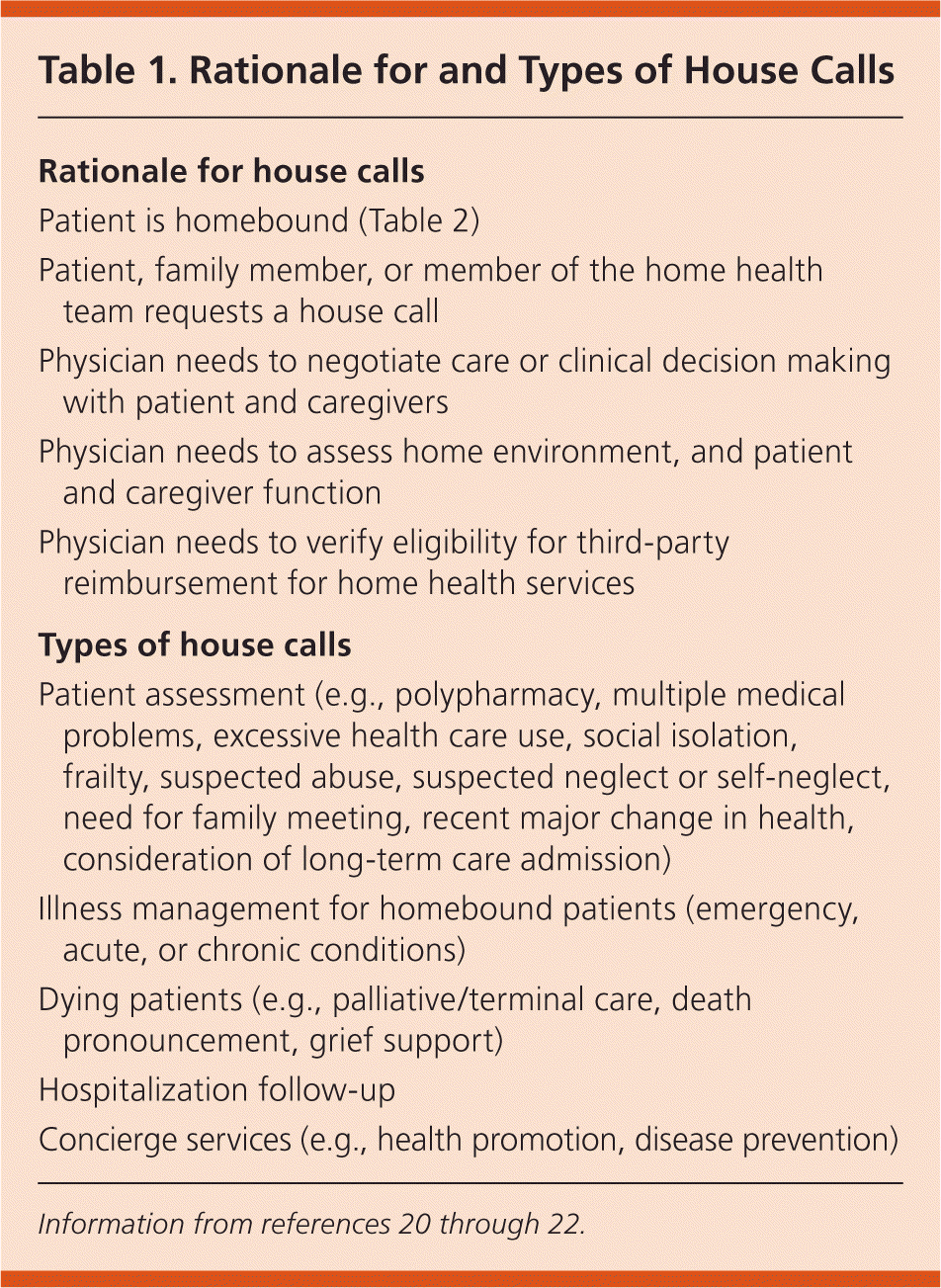
| Rationale for house calls |
| Patient is homebound (Table 2) |
| Patient, family member, or member of the home health team requests a house call |
| Physician needs to negotiate care or clinical decision making with patient and caregivers |
| Physician needs to assess home environment, and patient and caregiver function |
| Physician needs to verify eligibility for third-party reimbursement for home health services |
| Types of house calls |
| Patient assessment (e.g., polypharmacy, multiple medical problems, excessive health care use, social isolation, frailty, suspected abuse, suspected neglect or self-neglect, need for family meeting, recent major change in health, consideration of long-term care admission) |
| Illness management for homebound patients (emergency, acute, or chronic conditions) |
| Dying patients (e.g., palliative/terminal care, death pronouncement, grief support) |
| Hospitalization follow-up |
| Concierge services (e.g., health promotion, disease prevention) |
For frail older patients who are homebound, the goals of a house call are to preserve functional status and prevent or delay institutionalization or hospital admission. Table 2 provides the current Medicare definition of homebound.24 For patients with chronic conditions, such as heart disease, renal failure, or chronic obstructive pulmonary disease, the goals also include maximizing symptom control. For patients with advanced dementia, the goals may shift to emphasizing evaluation of home safety or the ability to live independently. Physicians can also evaluate caregivers' abilities to provide in-home care. For recently hospitalized patients, the goals include identifying the impact of functional decline, evaluating home safety, identifying medication discrepancies in the transition to home, and monitoring symptoms.
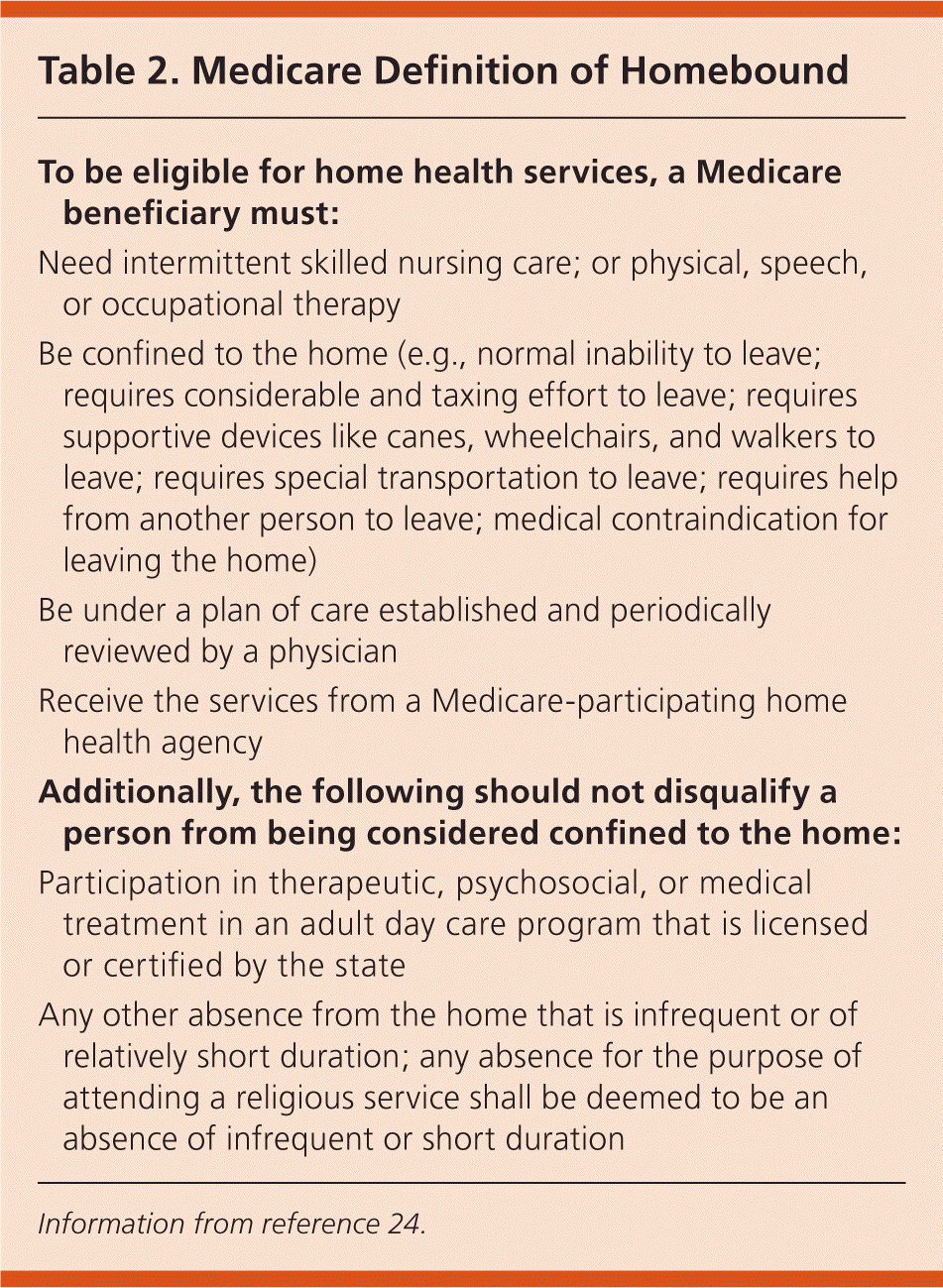
| To be eligible for home health services, a Medicare beneficiary must: |
| Need intermittent skilled nursing care; or physical, speech, or occupational therapy |
| Be confined to the home (e.g., normal inability to leave; requires considerable and taxing effort to leave; requires supportive devices like canes, wheelchairs, and walkers to leave; requires special transportation to leave; requires help from another person to leave; medical contraindication for leaving the home) |
| Be under a plan of care established and periodically reviewed by a physician |
| Receive the services from a Medicare-participating home health agency |
| Additionally, the following should not disqualify a person from being considered confined to the home: |
| Participation in therapeutic, psychosocial, or medical treatment in an adult day care program that is licensed or certified by the state |
| Any other absence from the home that is infrequent or of relatively short duration; any absence for the purpose of attending a religious service shall be deemed to be an absence of infrequent or short duration |
The goals of house calls for palliative care focus on symptom assessment and management, as well as monitoring the support of caregivers. Visits to dying patients can occur in partnership with hospice services. Family physicians can provide valuable psychosocial support to patients and their families before and after death. Continued involvement in caring for patients with terminal cancer may improve end-of-life care and reduce the likelihood of death in the hospital.25 A systematic review demonstrated that home care, and the intensity of that care, is strongly associated with a patient-preferred home death rather than death in the hospital.26
Conducting House Calls
Advance planning is necessary to develop the anticipated agenda of a house call. This may include logistics (e.g., supplies, patient education materials), obtaining directions and patient contact information, confirming the visit with the patient and caregivers, and coordinating with other home health care professionals.
The INHOMESSS mnemonic (impairments/immobility, nutrition, home environment, other people, medications, examination, safety, spiritual health, services) addresses the components of a comprehensive house call. A sample checklist that incorporates these items is provided in Figure 1.20 Specific elements of the INHOMESSS assessment can be conducted independently based on the needs of the patient and the physician's agenda. The comprehensive evaluation begins with an assessment of the patient's neighborhood and exterior of the home, specifically the ease of entering or exiting the home. Home modifications to assist older adults with disabilities are described in a previous article in American Family Physician (https://www.aafp.org/afp/2009/1101/p963.html).
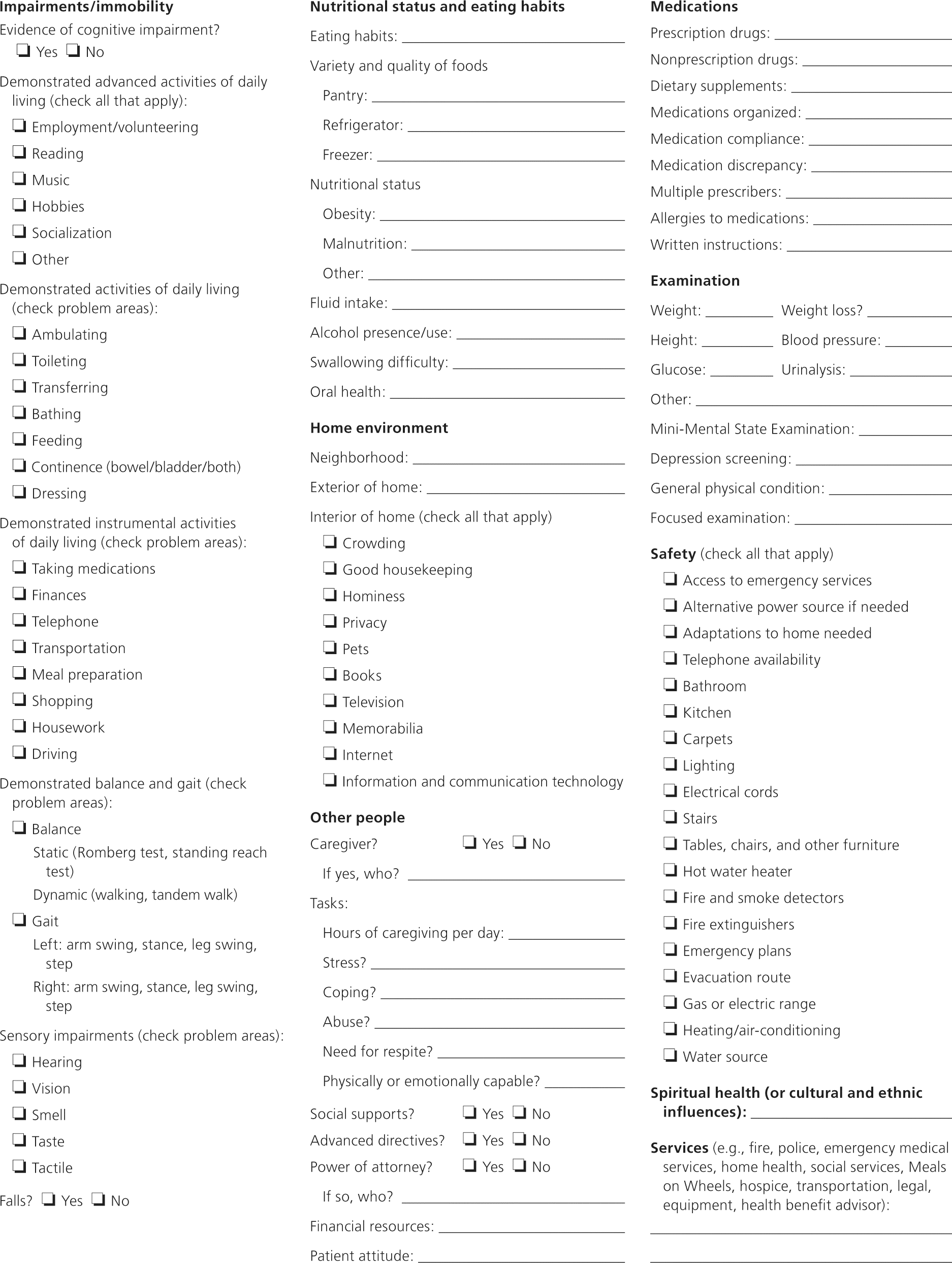
One approach to assessing the patient's functioning at home is to observe the patient performing daily activities. Activities of daily living (especially transfer skills) are demonstrated by getting in and out of bed, on and off of the toilet, and in and out of the bathtub or shower. Other self-care skills include performing hygiene tasks, getting dressed, taking medications, doing housework, and preparing food. Observing the patient-caregiver interaction can provide insight into the relationship.
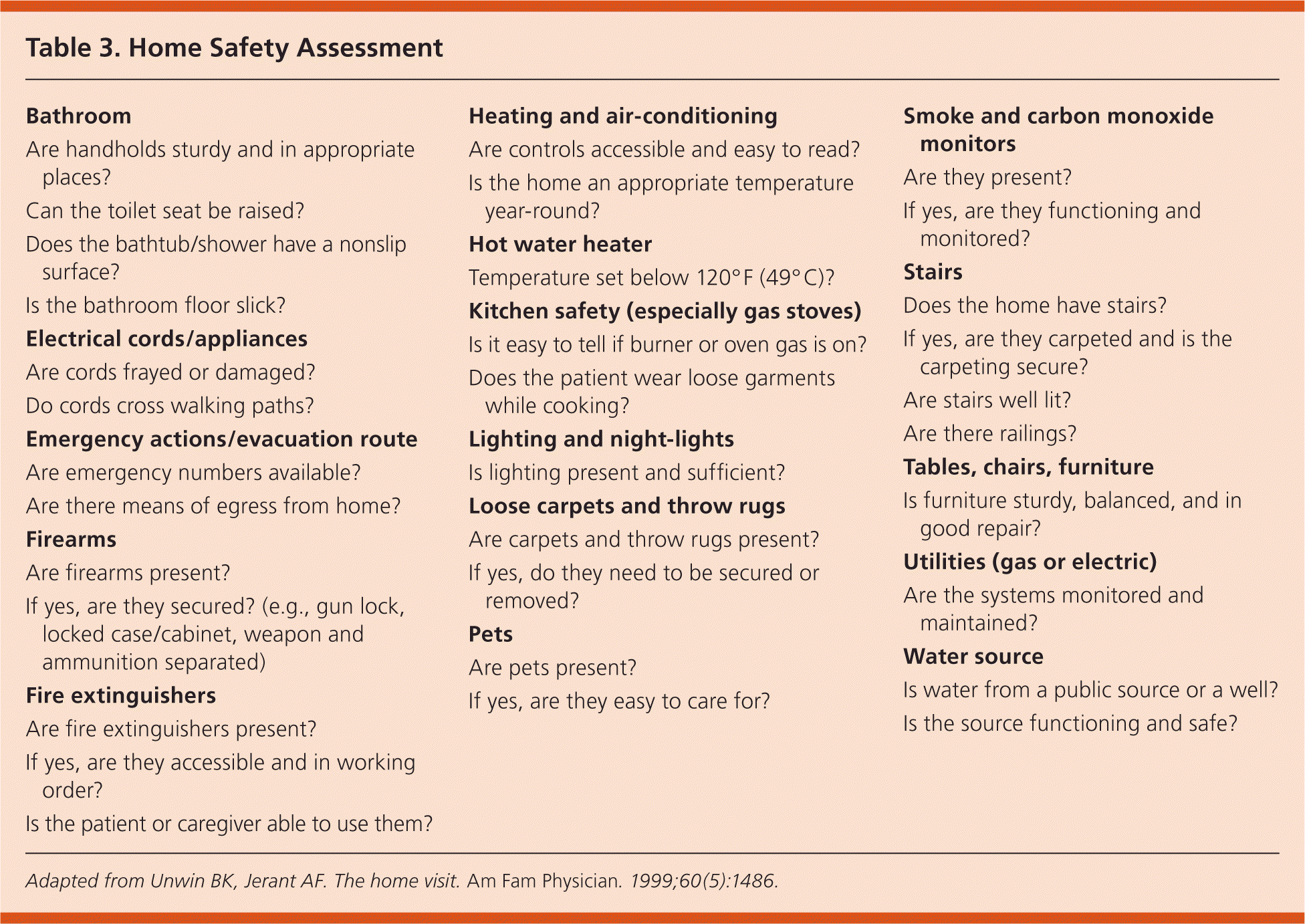
Medication review and reconciliation is a necessity at every house call. Approximately 14 to 50 percent of older patients may experience medication discrepancies, which are associated with increased rates of rehospitalization.14,27 Discrepancies may be related to patient factors, such as nonadherence or problems obtaining prescription medications. Other factors may also play a role, including prescriptions for different doses of the same medication, errors in discharge medication lists, incorrect labeling, or prescriptions for medications to which the patient is allergic.14,27
Incorporating House Calls into Practice
Incorporating house calls into regular workflow can be challenging. The biggest barriers are travel time, disruption of the office schedule, and a perception of lost revenue. With careful planning, house calls can be a rewarding patient encounter and a refreshing change from clinical routine. Strategies to incorporate house calls into practice include scheduling visits before or after office hours, or incorporating a visit into other business or personal travel. Some physician practices have developed mobile office vehicles for home care services.
Efficient scheduling and coordination of care is essential. Patients are often frail or cognitively impaired, and are at increased risk of becoming lost to medical follow-up; therefore, a dedicated system for tracking is helpful. Working with a chronic disease nurse may help with tracking and coordinating care. Because most visits involve chronic disease management, they can be scheduled in advance and planned by geographic areas, such as by zip code, to minimize driving time between visits. Trip planning software can help avoid delays from poor directions. Table 4 lists suggested supplies for routine house calls.20
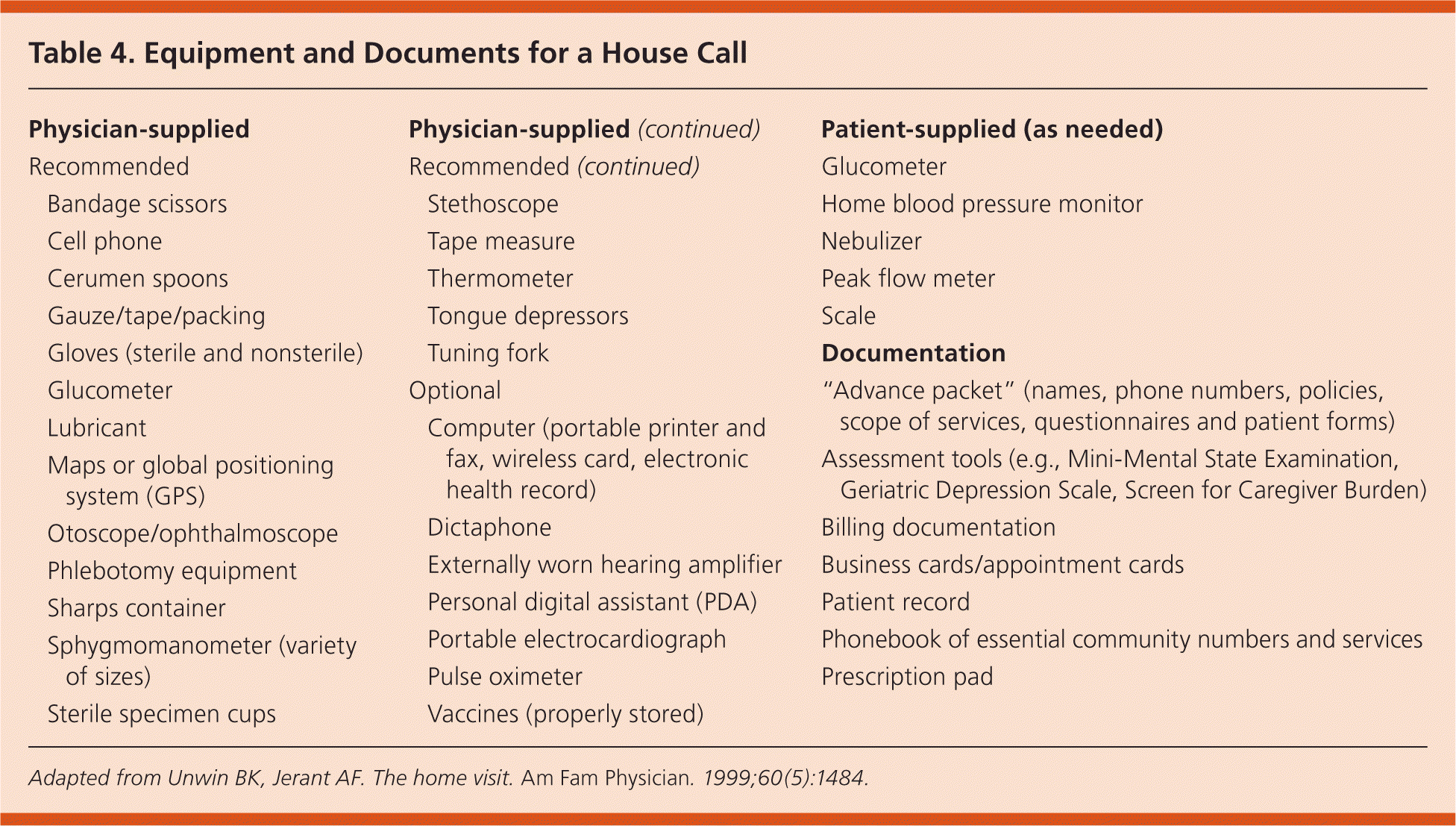
To enhance communication and improve efficiency of care, physicians should coordinate house calls with other health care professionals, such as hospice team members. Examples of health care professionals whose visits can be arranged through a home health agency include the following: dietitian, home health aide, licensed practical nurse, occupational therapist, physical therapist, psychiatric nurse, registered nurse, social worker, speech therapist, and wound care nurse. Wound care can be more efficiently evaluated and managed in conjunction with a nurse partner, and joint visits minimize the need for dressing removals. Hospice visits can include completion of necessary controlled substance refills to avoid delays. Home health and hospice documentation can also be completed.
Providing urgent care for homebound patients is challenging, but possible. Partnering with nurse practitioners can be effective in providing emergent care with minimal disruption to office practice, and can help to avoid the need to transfer the patient out of the home. Advanced planning can mitigate some of the problems associated with home care for acute conditions. An emergency kit of likely medications and supplies can be maintained in the patient's home for use by caregivers, home health nurses, or other clinicians (Table 5).
| Condition | Medication |
|---|---|
| Agitation | Haloperidol (2 mg) for subcutaneous or intramuscular administration |
| Dehydration | Supplies for hypodermoclysis, including intravenous fluids, infusion set, butterfly needles (21 gauge), tape, occlusive dressing |
| Dyspnea | Benzodiazepine for subcutaneous or sublingual administration |
| Opioid for subcutaneous or sublingual administration | |
| Heart failure | Furosemide for subcutaneous administration |
| Pain | Opioid for subcutaneous or sublingual administration |
| Seizure | Diazepam (Diastat; 10 mg) for rectal administration |
Documenting house calls is similar to documenting an outpatient clinical visit, but the chief complaint must include justification of the reason for the visit to occur in the home (e.g., patient immobility or other cognitive or emotional inability to go to the office; need for the physician to assess home environment or caregivers). Using a structured visit template can help physicians consistently document common issues encountered during visits. House call billing codes are listed in Table 6.28 A health care professional communication log may be maintained at the patient's home to briefly record visits and care plan changes performed by various home care services. Copies of the visit note may be left with the patient if needed. Some electronic health records can document the house call and bill Medicare wirelessly for the service. Portable printers can also be used to print necessary documents and patient education materials.
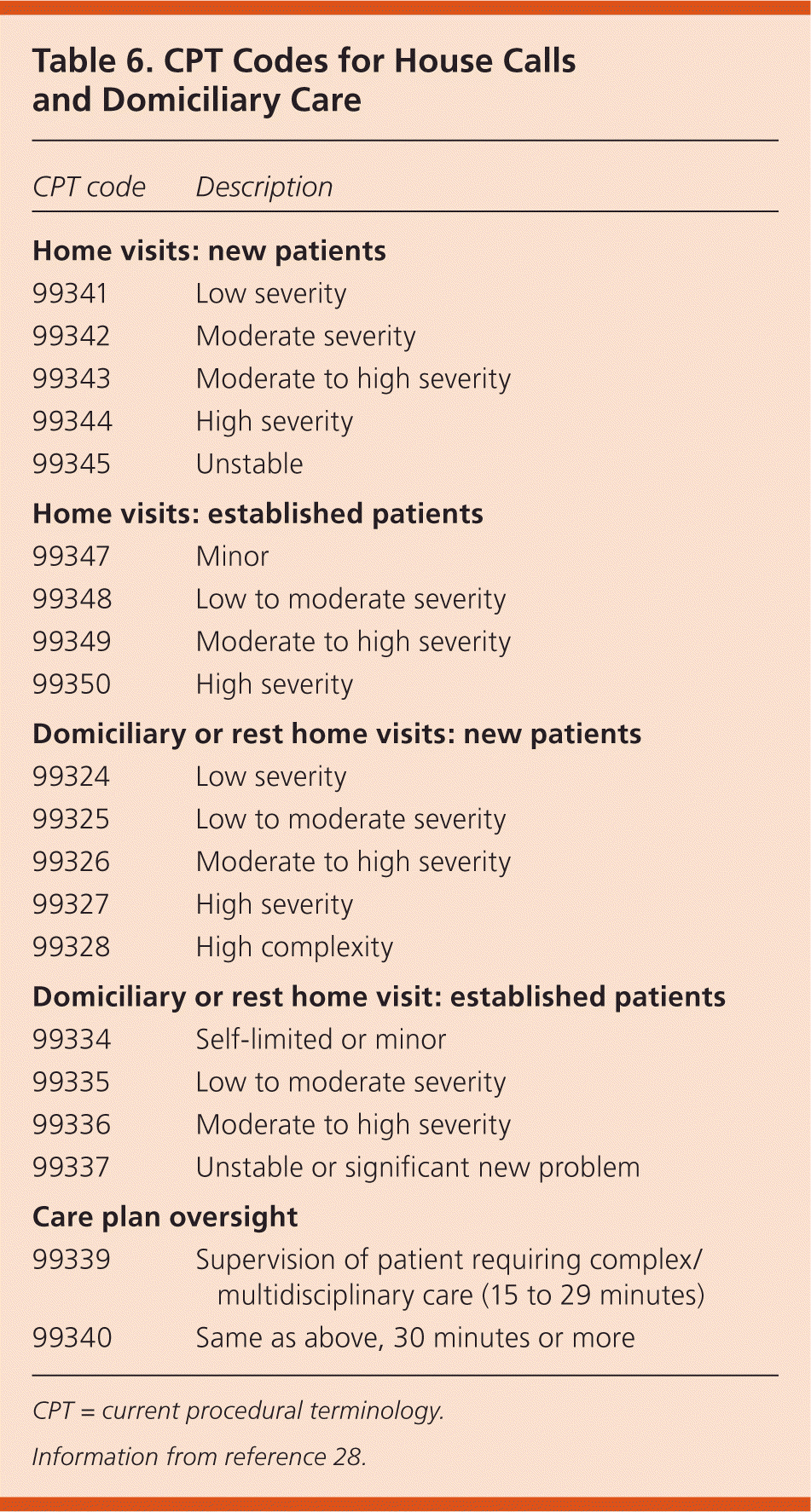
| CPT code | Description |
|---|---|
| Home visits: new patients | |
| 99341 | Low severity |
| 99342 | Moderate severity |
| 99343 | Moderate to high severity |
| 99344 | High severity |
| 99345 | Unstable |
| Home visits: established patients | |
| 99347 | Minor |
| 99348 | Low to moderate severity |
| 99349 | Moderate to high severity |
| 99350 | High severity |
| Domiciliary or rest home visits: new patients | |
| 99324 | Low severity |
| 99325 | Low to moderate severity |
| 99326 | Moderate to high severity |
| 99327 | High severity |
| 99328 | High complexity |
| Domiciliary or rest home visit: established patients | |
| 99334 | Self-limited or minor |
| 99335 | Low to moderate severity |
| 99336 | Moderate to high severity |
| 99337 | Unstable or significant new problem |
| Care plan oversight | |
| 99339 | Supervision of patient requiring complex/multidisciplinary care (15 to 29 minutes) |
| 99340 | Same as above, 30 minutes or more |
Personal Safety
Physicians may be concerned about personal safety while conducting house calls. Common sense practices include keeping staff informed of planned departure and return times, not carrying narcotics or other controlled substances, and avoiding unsafe areas. It may be advisable to avoid carrying a doctor's bag or wearing a white coat so as not to stand out as a physician in neighborhoods where personal safety is an issue.
Potential Impact of Health Systems Innovation
House calls can be an important component of the patient-centered medical home. The joint principles of the patient-centered medical home state that each patient should have a personal physician, physician-directed care, and expanded access to care.29 For the homebound, frail older patients, house calls are essential to manage care and enhance its quality. The joint principles also emphasize that payments should reflect the value of care management. The Patient Protection and Affordable Care Act will create a demonstration project based on the Veterans Affairs' Home Based Primary Care model, and will reimburse physicians for the comprehensive oversight of vulnerable older patients.
